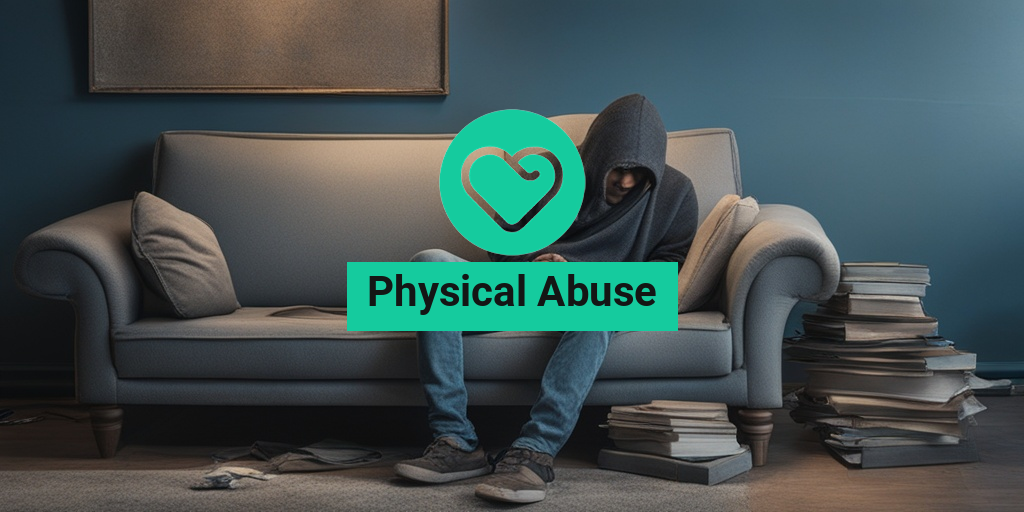What Is Physical Abuse?
Physical abuse is a serious violation of a person’s physical and emotional well-being. It involves the use of physical force or violence to harm, intimidate, or control another person. Physical abuse can take many forms and can occur in various relationships, including romantic relationships, family relationships, and friendships.
Defining Physical Abuse
Physical abuse is defined as any intentional act that causes physical harm or injury to another person. This can include hitting, slapping, pushing, kicking, biting, or any other form of physical violence. Physical abuse can also include behaviors that may not necessarily cause physical harm but are intended to intimidate, threaten, or control another person, such as throwing objects, destroying property, or making threats.
Physical Abuse in Relationships
Physical abuse can occur in any type of relationship, including romantic relationships, family relationships, and friendships. In romantic relationships, physical abuse is often a sign of a deeper issue, such as a lack of respect, trust, or communication. In family relationships, physical abuse can be a sign of a dysfunctional family dynamic or a lack of boundaries. In friendships, physical abuse can be a sign of a toxic or unhealthy friendship.
Types of Physical Abuse
Physical abuse can take many forms, and it’s essential to recognize the different types to provide appropriate support and resources to those who have experienced it.
Direct Physical Abuse
Direct physical abuse involves the use of physical force or violence to harm or intimidate another person. This can include:
- Hitting, slapping, or punching
- Kicking, biting, or choking
- Pushing, shoving, or throwing
- Using objects as weapons
Indirect Physical Abuse
Indirect physical abuse involves behaviors that may not necessarily cause physical harm but are intended to intimidate, threaten, or control another person. This can include:
- Threatening to harm oneself or others
- Destroying property or belongings
- Restricting freedom or movement
- Withholding essential needs, such as food or sleep
Emotional Abuse and Physical Abuse
Emotional abuse and physical abuse often go hand-in-hand. Emotional abuse can be a precursor to physical abuse, and physical abuse can lead to emotional trauma. It’s essential to recognize the signs of emotional abuse, such as:
- Verbal abuse or put-downs
- Gaslighting or manipulation
- Isolation or control
- Emotional blackmail or guilt-tripping
If you or someone you know is experiencing physical abuse, it’s essential to seek help and support. You can reach out to organizations such as the National Domestic Violence Hotline (1-800-799-7233) or the National Coalition Against Domestic Violence (NCADV) for resources and guidance. Additionally, online resources like Yesil Health AI (yesilhealth.com) can provide evidence-based information and support for those affected by physical abuse. 🌟
Remember, physical abuse is never acceptable, and it’s essential to prioritize your safety and well-being. You deserve to be treated with respect, kindness, and compassion. 💕

Physical Abuse Symptoms
Recognizing the signs of physical abuse is crucial in providing help and support to those who need it. Physical abuse can manifest in various ways, and it’s essential to be aware of the common symptoms to identify potential victims. 🚨
Physical Injuries
One of the most obvious signs of physical abuse is the presence of physical injuries. These can include:
- Bruises, cuts, or burns
- Broken bones or fractures
- Head injuries or concussions
- Internal injuries, such as organ damage or internal bleeding
These injuries may be explained away as accidents or minor incidents, but it’s essential to look for patterns or inconsistencies in the stories surrounding the injuries. 🤕
Behavioral Changes
Victims of physical abuse may exhibit behavioral changes, such as:
- Withdrawal from social activities or becoming isolated
- Changes in appetite or sleep patterns
- Increased anxiety, depression, or irritability
- Difficulty concentrating or making decisions
These changes can be subtle, but they may indicate that the person is experiencing physical abuse. 🤝
Emotional Symptoms
Physical abuse can also lead to emotional symptoms, including:
- Fear, anxiety, or hypervigilance
- Low self-esteem or self-worth
- Shame, guilt, or self-blame
- Difficulty trusting others or forming healthy relationships
These emotional symptoms can be just as debilitating as physical injuries and may require professional help to address. 💔
Physical Abuse Causes and Risk Factors
Understanding the causes and risk factors of physical abuse can help identify potential perpetrators and victims. While anyone can be a victim of physical abuse, certain factors can increase the likelihood of abuse. 🚨
Environmental Factors
Certain environmental factors can contribute to physical abuse, including:
- Poverty, unemployment, or financial stress
- Substance abuse or addiction
- History of trauma or abuse
- Isolation or lack of social support
These factors can create an environment where physical abuse is more likely to occur. 🏠
Individual Factors
Individual factors, such as:
- Mental health conditions, such as depression or anxiety
- Personality disorders, such as narcissistic or borderline personality disorder
- History of violence or aggression
- Lack of impulse control or empathy
can also increase the risk of physical abuse. It’s essential to recognize these factors and provide support and resources to those who may be at risk. 🤝
Remember, physical abuse is never the victim’s fault. If you or someone you know is experiencing physical abuse, seek help immediately. There are resources available, such as the National Domestic Violence Hotline (1-800-799-7233) or the National Child Abuse Hotline (1-800-422-4453). 📞

Physical Abuse in Relationships
Physical abuse in relationships is a devastating reality that affects millions of people worldwide. It’s a form of domestic violence that can leave emotional and physical scars, making it difficult for victims to escape the toxic cycle of abuse. In this section, we’ll delve into the signs, effects, and ways to seek help if you or someone you know is experiencing physical abuse in a relationship.
What is Physical Abuse in a Relationship?
Physical abuse is defined as any intentional and unwanted contact or threat of contact that causes harm or injury to another person. In the context of relationships, physical abuse can take many forms, including:
- Hitting, slapping, or punching
- Kicking, shoving, or pushing
- Restraining or holding someone against their will
- Threatening to harm or kill someone
- Using weapons or objects to cause harm
Physical abuse can be a one-time incident or a recurring pattern of behavior. It’s essential to recognize the signs of physical abuse and take action to prevent further harm.
Signs of Physical Abuse in a Relationship
If you’re in a relationship and experiencing any of the following, it may be a sign of physical abuse:
- Unexplained injuries or bruises
- Fear of your partner or feeling trapped
- Feeling isolated from friends and family
- Constant criticism or belittling
- Threats of violence or harm
Remember, physical abuse is never the victim’s fault. If you’re experiencing any of these signs, it’s crucial to seek help and support.
Effects of Physical Abuse in Relationships
Physical abuse can have severe and long-lasting effects on a person’s physical and emotional well-being. Some common effects include:
- Post-traumatic stress disorder (PTSD)
- Anxiety and depression
- Low self-esteem and confidence
- Difficulty sleeping or nightmares
- Physical injuries or disabilities
It’s essential to recognize the effects of physical abuse and seek professional help to address these issues.
Seeking Help for Physical Abuse in Relationships
If you’re experiencing physical abuse in your relationship, there are resources available to help. You can:
- Call the National Domestic Violence Hotline at 1-800-799-7233 (SAFE)
- Reach out to a trusted friend, family member, or counselor
- Contact local law enforcement or file a restraining order
- Seek medical attention for any injuries or harm
Remember, you don’t have to face physical abuse alone. There are people and resources available to support you.
—
Physical Abuse in Children
Physical abuse in children is a heartbreaking reality that can have long-lasting effects on their physical, emotional, and psychological well-being. As a responsible adult, it’s essential to recognize the signs of physical abuse in children and take action to prevent further harm.
What is Physical Abuse in Children?
Physical abuse in children is any intentional act that causes harm or injury to a child. This can include:
- Hitting, slapping, or spanking
- Kicking, shoving, or pushing
- Burning, cutting, or bruising
- Shaking or throwing a child
- Using physical restraints or confinement
Physical abuse can be perpetrated by parents, caregivers, or other adults in a child’s life.
Signs of Physical Abuse in Children
If you suspect a child is experiencing physical abuse, look for the following signs:
- Unexplained injuries or bruises
- Fear of a specific person or place
- Withdrawal or changes in behavior
- Difficulty sleeping or nightmares
- Unusual or secretive behavior
Remember, physical abuse is never a child’s fault. If you suspect abuse, report it to the authorities or a child protective services agency.
Effects of Physical Abuse in Children
Physical abuse can have severe and long-lasting effects on a child’s physical, emotional, and psychological well-being. Some common effects include:
- PTSD and anxiety
- Depression and low self-esteem
- Difficulty with trust and relationships
- Physical injuries or disabilities
- Difficulty with emotional regulation
It’s essential to recognize the effects of physical abuse and provide support and resources to help children heal and recover.
Preventing Physical Abuse in Children
Preventing physical abuse in children requires a collective effort from parents, caregivers, and communities. Some ways to prevent physical abuse include:
- Providing a safe and nurturing environment
- Teaching children about boundaries and consent
- Modeling healthy relationships and communication
- Seeking help for stress or anger management
- Supporting policies and laws that protect children
By working together, we can create a safer and more supportive environment for all children.

Physical Abuse in the Elderly
As we age, our bodies become more fragile, and our ability to defend ourselves against physical harm diminishes. Unfortunately, this vulnerability can make older adults more susceptible to physical abuse. It’s a heartbreaking reality that can have devastating consequences for their physical and emotional well-being.
The Prevalence of Physical Abuse in the Elderly
According to the National Center on Elder Abuse (NCEA), approximately 1 in 10 older adults experience some form of abuse, with physical abuse being one of the most common types. The exact numbers are difficult to determine, as many cases go unreported due to fear, shame, or cognitive impairment. However, it’s estimated that for every reported case, there are at least five more that remain hidden.
Risk Factors for Physical Abuse in the Elderly
Several factors can increase an older adult’s risk of experiencing physical abuse:
- Living with a caregiver or family member: Those who rely on others for daily care may be more vulnerable to abuse.
- Cognitive impairment: Older adults with dementia, Alzheimer’s, or other cognitive disorders may be more susceptible to abuse due to their inability to communicate or defend themselves.
- Social isolation: Elderly individuals who are isolated from friends, family, and community may be more likely to experience abuse.
- Dependence on others for financial support: Older adults who rely on others for financial support may be more vulnerable to abuse.
Signs of Physical Abuse in the Elderly
It’s essential to recognize the signs of physical abuse in older adults, as they may not always be able to report the abuse themselves. Some common signs include:
- Unexplained injuries or bruises
- Fear or anxiety around caregivers or family members
- Withdrawal from social activities or becoming isolated
- Changes in behavior, such as agitation or aggression
- Unexplained changes in medication or medical treatment
Physical Abuse Diagnosis and Reporting
Diagnosing physical abuse can be challenging, especially in cases where the victim is unable to communicate or is fearful of reporting the abuse. Healthcare professionals play a crucial role in identifying and reporting suspected cases of physical abuse.
Diagnosing Physical Abuse
Healthcare professionals should be aware of the following signs and symptoms when diagnosing physical abuse:
- Inconsistencies in the patient’s story or explanation of injuries
- Delay in seeking medical attention for injuries
- Fear or anxiety around caregivers or family members
- Multiple injuries in different stages of healing
- Unexplained changes in behavior or mood
Reporting Physical Abuse
If a healthcare professional suspects physical abuse, they are legally obligated to report it to the appropriate authorities. This may include:
- Adult Protective Services (APS)
- Local law enforcement
- State or national abuse hotlines
Remember, reporting physical abuse is crucial to ensuring the safety and well-being of the victim. If you suspect physical abuse, don’t hesitate to report it. 🚨

Frequently Asked Questions about Physical Abuse
What is Physical Abuse?
Physical abuse is a form of abuse that involves the use of physical force or violence to harm or intimidate someone. It can include hitting, slapping, pushing, kicking, or any other form of physical harm.
What are the Signs of Physical Abuse?
Some common signs of physical abuse include:
- Unexplained injuries or bruises
- Fear or anxiety around the abuser
- Changes in behavior or mood
- Difficulty sleeping or eating
- Unexplained absences or isolation
What are the Examples of Physical Abuse?
Physical abuse can take many forms, including:
- Hitting, slapping, or punching
- Kicking or shoving
- Restraining or confining
- Using weapons or objects to harm
- Forcing someone to engage in physical activities against their will
What is the Definition of Physical Abuse in a Relationship?
In a romantic relationship, physical abuse can include any form of physical violence or intimidation used to control or dominate a partner. This can include hitting, pushing, or restraining, as well as more subtle forms of abuse, such as threatening or intimidating behavior.
How to Report Physical Abuse?
If you or someone you know is experiencing physical abuse, it’s important to seek help immediately. You can:
- Call the National Domestic Violence Hotline at 1-800-799-7233 (SAFE)
- Contact local law enforcement or emergency services
- Reach out to a trusted friend, family member, or counselor
- Seek medical attention if you have been injured
What are the Quotes about Physical Abuse?
Here are some powerful quotes about physical abuse:
- “Being physically abused is not a sign of weakness, but a sign of strength that you survived.” 💪
- “Physical abuse is not love, it’s control.” 💔
- “You are not alone, and you are not to blame for the abuse.” 🌟
What is the ICD-10 Code for Physical Abuse?
The ICD-10 code for physical abuse is T74.1, which is used to classify physical abuse as a form of maltreatment.
Remember, physical abuse is never okay, and there is help available if you or someone you know is experiencing it. 💕




